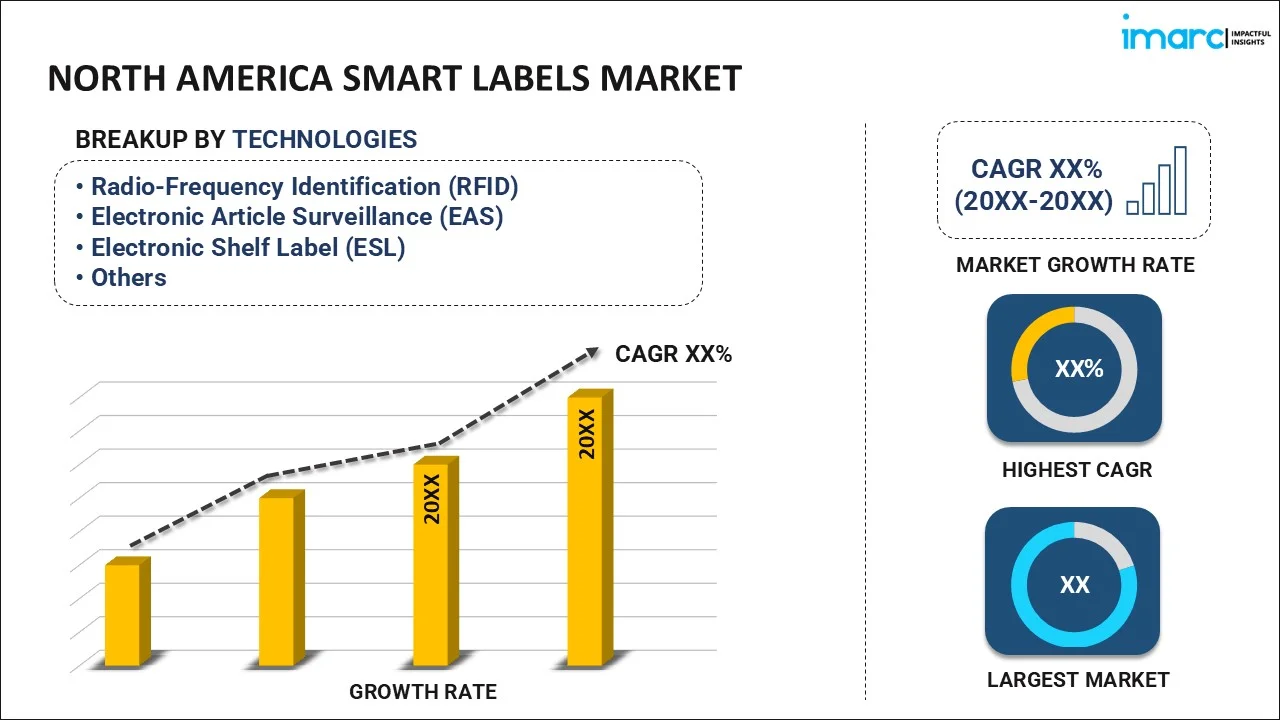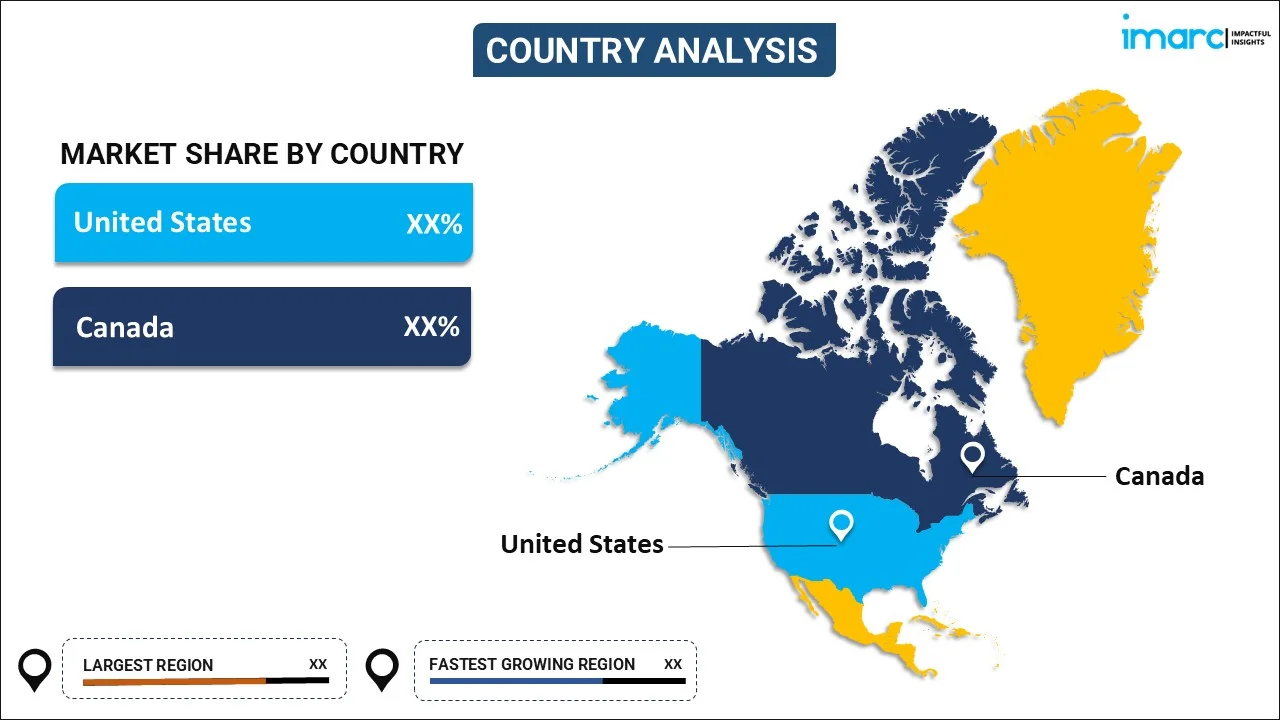
North America Smart Labels Market Report by Technology (Radio-Frequency Identification (RFID), Electronic Article Surveillance (EAS), Electronic Shelf Label (ESL), Sensing Labels, Near Field Communication (NFC)), Component (Batteries, Transceivers, Microprocessors, Memories, and Others), End User (Retail, Logistics and Transportation, Healthcare, Food and Beverage, and Others), and Country 2025-2033
Market Overview 2025-2033:
The North America smart labels market size reached USD 5.4 Billion in 2024. Looking forward, IMARC Group expects the market to reach USD 14.1 Billion by 2033, exhibiting a growth rate (CAGR) of 10.7% during 2025-2033. The increasing adoption of RFID technology in numerous industries, growing demand for improved supply chain efficiency and visibility, stringent government regulations regarding product traceability and authentication, and the rising popularity of e-commerce and online shopping are major key factors driving the market growth.
|
Report Attribute
|
Key Statistics |
|---|---|
|
Base Year
|
2024 |
|
Forecast Years
|
2025-2033 |
|
Historical Years
|
2019-2024
|
|
Market Size in 2024
|
USD 5.4 Billion |
|
Market Forecast in 2033
|
USD 14.1 Billion |
| Market Growth Rate (2025-2033) | 10.7% |
Smart labels are innovative identification tags that integrate advanced technologies to provide additional functionality beyond traditional labels. These labels incorporate elements such as radio frequency identification (RFID), near field communication (NFC), or (quick Response (QR) codes, enabling seamless communication with compatible devices. They can be attached to various products, packages, or items to enable real-time tracking, inventory management, and authentication. Smart labels can store and transmit information, such as product details, expiration dates, and shipping information, making them valuable in supply chain management and retail applications. They offer enhanced convenience, efficiency, and security by leveraging technology to streamline processes and enable data-driven decision-making.
The increasing adoption of RFID technology in various industries is a major factor driving the market. RFID-based smart labels offer real-time tracking, inventory management, and anti-counterfeiting capabilities, which are crucial for sectors like retail, logistics, and healthcare. Additionally, the growing demand for improved supply chain efficiency and visibility is boosting the market. Smart labels enable accurate and automated data capture, reducing manual errors and improving overall operational efficiency. They facilitate inventory management, asset tracking, and product authentication, leading to cost savings and enhanced customer satisfaction. Besides this, stringent government regulations regarding product traceability and authentication are propelling the adoption of smart labels. Industries, such as pharmaceuticals, food and beverage, and automotive, are increasingly required to comply with labeling standards to ensure consumer safety and prevent counterfeit products from entering the market. Moreover, the rising popularity of e-commerce and online shopping is driving the product demand. These labels enable seamless tracking of packages, provide delivery notifications, and enhance the overall customer experience.
North America Smart Labels Market Trends/Drivers:
Increasing adoption of RFID technology in numerous industries
RFID-enabled smart labels offer real-time tracking, accurate inventory management, and enhanced security features. Industries, such as retail, logistics, healthcare, and manufacturing, are embracing RFID technology to improve operational efficiency, reduce manual errors, and enhance supply chain visibility. The benefits of RFID technology, including seamless data capture, automated identification, and anti-counterfeiting capabilities, are driving the demand for smart labels in North America. As a result, the market is expanding as more businesses recognize the value and advantages of integrating RFID technology into their labeling systems.
Growing demand for improved supply chain efficiency and visibility
Smart labels enable real-time tracking, accurate inventory management, and seamless communication throughout the supply chain. By incorporating technologies like RFID, NFC, or QR codes, smart labels facilitate automated data capture, reducing manual errors and streamlining processes. They enhance supply chain visibility by providing accurate and up-to-date information on product location, status, and movement. As businesses strive for improved operational efficiency, cost savings, and enhanced customer satisfaction, the demand for smart labels continues to rise across the region.
North America Smart Labels Industry Segmentation:
IMARC Group provides an analysis of the key trends in each segment of the North America smart labels market report, along with forecasts at the regional and country levels from 2025-2033. Our report has categorized the market based on technology, component and end user.
Breakup by Technology:

- Radio-frequency identification (RFID)
- Electronic article surveillance (EAS)
- Electronic shelf label (ESL)
- Sensing labels
- Near field communication (NFC)
Radio-frequency identification (RFID) dominates the market
The report has provided a detailed breakup and analysis of the market based on technology. This includes radio-frequency identification (RFID), electronic article surveillance (EAS), electronic shelf label (ESL), sensing labels, and near field communication (NFC). Radio-frequency identification (RFID) represented the largest segment.
RFID technology is widely used in the industry due to its ability to provide real-time tracking, inventory management, and authentication. RFID tags can store and transmit data wirelessly, allowing seamless communication with compatible devices. They enable businesses to track and locate items accurately, automate inventory management processes, and improve supply chain visibility. The non-contact nature of RFID technology also ensures quick and efficient data capture, reducing manual errors and enhancing operational efficiency.
Breakup by Component:
- Batteries
- Transceivers
- Microprocessors
- Memories
- Others
Memories account for the majority of the overall market share
A detailed breakup and analysis of the market based on the component has also been provided in the report. This includes batteries, transceivers, microprocessors, memories, and others. According to the report, memories accounted for the largest segment.
Batteries are widely used in smart labels to provide a reliable and independent power source. They enable smart labels to operate autonomously without relying on external power or connectivity. By incorporating batteries, smart labels can continuously transmit and receive data, ensuring uninterrupted functionality. These batteries are typically designed to be compact, long-lasting, and easily replaceable, allowing smart labels to operate for extended periods without the need for frequent maintenance or recharging.
Breakup by End User:
- Retail
- Logistics and transportation
- Healthcare
- Food and beverage
- Others
Retail represents the largest end user segment
A detailed breakup and analysis of the market has been provided based on end user. This includes retail, logistics and transportation, healthcare, food and beverage, and others. According to the report, retail represented the largest segment.
In the retail industry, smart labels are used for various applications such as inventory management, price automation, and customer engagement. Retailers utilize smart labels to track and manage their inventory in real-time, enabling accurate stock levels, reducing out-of-stock situations, and optimizing replenishment processes. Smart labels with electronic shelf labels (ESL) provide dynamic pricing and promotional information, enhancing pricing accuracy and flexibility. Additionally, retailers can leverage smart labels for personalized customer experiences, utilizing technologies like NFC or QR codes to provide additional product information or enable mobile payments.
Breakup by Country:

- United States
- Canada
United States exhibits a clear dominance in the market
A detailed breakup and analysis of the market has been provided based on end user. This includes united states, canada. According to the report, United States was the largest market.
The United States is often an early adopter of new technologies, due to which companies across various sectors across the country have been quick to implement smart label technologies to improve their operations. Other than this, the healthcare sector in the United States, which includes large hospitals and pharmaceutical companies, uses smart labels for tracking and managing medical equipment, medication, and supplies. Moreover, smart labels have been increasingly utilized in the e-commerce sector, which has seen significant growth in the U.S., particularly amid the COVID-19 pandemic. These labels improve the efficiency of warehousing operations and package tracking, thus accelerating the product adoption rate.
Competitive Landscape:
The market exhibits a moderate to high level of competition among existing players. The market is characterized by the presence of established companies offering a wide range of smart label solutions and technologies. Key players in the industry have already established strong customer relationships, distribution networks, and technological expertise, giving them a competitive advantage. These companies often engage in strategic partnerships, acquisitions, and product innovations to maintain their market position. However, the threat of new entrants in the market cannot be ignored. The market's potential for growth and the increasing adoption of smart label technologies attract the interest of new players. The entry barriers can vary, including the need for substantial investment in research and development, manufacturing capabilities, and establishing distribution networks. However, advancements in technology and the availability of outsourcing options can reduce these barriers.
The report has provided a comprehensive analysis of the competitive landscape in the market. Detailed profiles of all major companies have also been provided.
North America Smart Labels Market Report Scope:
| Report Features | Details |
|---|---|
| Base Year of the Analysis | 2024 |
| Historical Period | 2019-2024 |
| Forecast Period | 2025-2033 |
| Units | Billion USD |
| Scope of the Report | Exploration of Historical and Forecast Trends, Industry Catalysts and Challenges, Segment-Wise Historical and Predictive Market Assessment:
|
| Technologies Covered | Radio-Frequency Identification (RFID), Electronic Article Surveillance (EAS), Electronic Shelf Label (ESL), Sensing Labels, and Near Field Communication (NFC) |
| Components Covered | Batteries, Transceivers, Microprocessors, Memories, Others |
| End-users Covered | Retail, Logistics and Transportation, Healthcare, Food and Beverage, Others |
| Countries Covered | United States, Canada |
| Customization Scope | 10% Free Customization |
| Post-Sale Analyst Support | 10-12 Weeks |
| Delivery Format | PDF and Excel through Email (We can also provide the editable version of the report in PPT/Word format on special request) |
Key Questions Answered in This Report:
- How has the North America smart labels market performed so far, and how will it perform in the coming years?
- What are the drivers, restraints, and opportunities in the North America smart labels market?
- What is the impact of each driver, restraint, and opportunity on the North America smart labels market?
- What are the key regional markets?
- Which countries represent the most attractive North America smart labels market?
- What is the breakup of the market based on technology?
- Which is the most attractive technology in the North America smart labels market?
- What is the breakup of the market based on the component?
- Which is the most attractive component in the North America smart labels market?
- What is the breakup of the market based on end user?
- Which is the most attractive end user in the North America smart labels market?
- What is the competitive structure of the North America smart labels market?
- Who are the key players/companies in the North America smart labels market?
Key Benefits for Stakeholders:
- IMARC’s report offers a comprehensive quantitative analysis of various market segments, historical and current market trends, market forecasts, and dynamics of the North America smart labels market from 2019-2033.
- The research study provides the latest information on the market drivers, challenges, and opportunities in the North America smart labels market.
- Porter's five forces analysis assist stakeholders in assessing the impact of new entrants, competitive rivalry, supplier power, buyer power, and the threat of substitution. It helps stakeholders to analyze the level of competition within the North America smart labels industry and its attractiveness.
- Competitive landscape allows stakeholders to understand their competitive environment and provides an insight into the current positions of key players in the market.
Need more help?
- Speak to our experienced analysts for insights on the current market scenarios.
- Include additional segments and countries to customize the report as per your requirement.
- Gain an unparalleled competitive advantage in your domain by understanding how to utilize the report and positively impacting your operations and revenue.
- For further assistance, please connect with our analysts.
 Inquire Before Buying
Inquire Before Buying
 Speak to an Analyst
Speak to an Analyst
 Request Brochure
Request Brochure
 Request Customization
Request Customization




.webp)




.webp)












